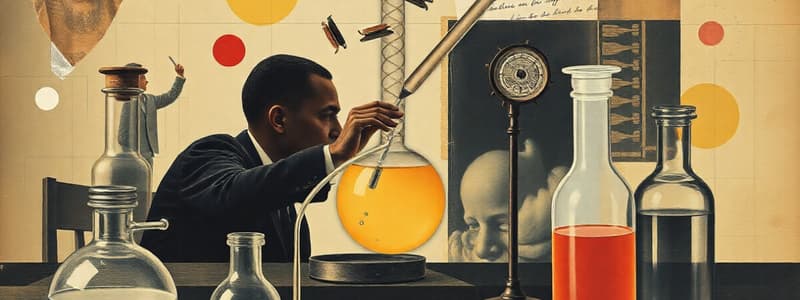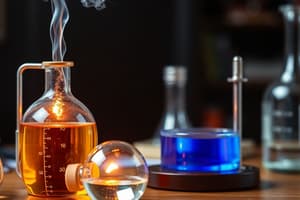Podcast
Questions and Answers
What is a circle graph used for?
What is a circle graph used for?
A circle graph, also known as a pie chart, is used to represent parts of a whole. It visually shows the proportion of different categories within a dataset, making it easy to compare their sizes.
How is the scientific method used?
How is the scientific method used?
The scientific method is a systematic approach to investigating phenomena. It starts with observation, followed by forming a hypothesis to explain the observation. Experiments are conducted to test the hypothesis, leading to data collection and analysis. The results either support or refute the hypothesis, guiding further investigation and refining the understanding of the phenomenon.
Why are social sciences not natural sciences?
Why are social sciences not natural sciences?
Social sciences deal with human behavior, societies, and cultures, while natural sciences focus on the physical world and its processes. Social sciences are more complex as they involve subjective experiences, cultural influences, and ethical considerations that are distinct from natural sciences.
What are the main ideas of physical science?
What are the main ideas of physical science?
What should you do if your experimental results do not fit your original hypothesis?
What should you do if your experimental results do not fit your original hypothesis?
Why are scientific theories never really proven?
Why are scientific theories never really proven?
Describe scientific models
Describe scientific models
Describe some safe laboratory procedures.
Describe some safe laboratory procedures.
Scientific notation: know it
Scientific notation: know it
Convert 20mm to cm
Convert 20mm to cm
Explain why 42.27 is more precise than 42.3
Explain why 42.27 is more precise than 42.3
Why is milk not a pure substance?
Why is milk not a pure substance?
What are the key characteristics of a compound?
What are the key characteristics of a compound?
What are the characteristics of a mixture?
What are the characteristics of a mixture?
What are the characteristics of a pure substance?
What are the characteristics of a pure substance?
What is viscosity?
What is viscosity?
Describe the properties of metals.
Describe the properties of metals.
How does filtration work to separate components of a mixture?
How does filtration work to separate components of a mixture?
Compare chemical and physical changes.
Compare chemical and physical changes.
Describe the arrangement of atoms in solids, liquids, and gases.
Describe the arrangement of atoms in solids, liquids, and gases.
Flashcards
What is a circle graph used for?
What is a circle graph used for?
A diagram that illustrates the proportion of parts that make up a whole entity. It's usually in the shape of a circle divided into segments representing each part.
How is the scientific method used?
How is the scientific method used?
A systematic method of investigating and understanding natural phenomena. It involves steps like observation, hypothesis formation, experimentation, analysis, and conclusion.
Why are social sciences not natural sciences?
Why are social sciences not natural sciences?
Social sciences focus on human behavior and society, while natural sciences study the physical universe. Social sciences use different methods to understand complex human interactions.
What are the main ideas of physical science?
What are the main ideas of physical science?
Signup and view all the flashcards
What should you do if your experimental results do not fit your original hypothesis?
What should you do if your experimental results do not fit your original hypothesis?
Signup and view all the flashcards
Why are scientific theories never really proven?
Why are scientific theories never really proven?
Signup and view all the flashcards
Describe scientific models
Describe scientific models
Signup and view all the flashcards
Describe some safe laboratory procedures.
Describe some safe laboratory procedures.
Signup and view all the flashcards
Scientific Notation
Scientific Notation
Signup and view all the flashcards
Convert 20mm to cm
Convert 20mm to cm
Signup and view all the flashcards
Explain why 42.27 is more precise than 42.3
Explain why 42.27 is more precise than 42.3
Signup and view all the flashcards
Why is milk not a pure substance?
Why is milk not a pure substance?
Signup and view all the flashcards
What are the key characteristics of a compound?
What are the key characteristics of a compound?
Signup and view all the flashcards
What are the characteristics of a mixture?
What are the characteristics of a mixture?
Signup and view all the flashcards
What are the characteristics of a pure substance?
What are the characteristics of a pure substance?
Signup and view all the flashcards
What is Viscosity?
What is Viscosity?
Signup and view all the flashcards
Describe the properties of metals.
Describe the properties of metals.
Signup and view all the flashcards
How does filtration work to separate components of a mixture?
How does filtration work to separate components of a mixture?
Signup and view all the flashcards
Compare chemical and physical changes.
Compare chemical and physical changes.
Signup and view all the flashcards
Describe the arrangement of atoms in solids, liquids, and gasses
Describe the arrangement of atoms in solids, liquids, and gasses
Signup and view all the flashcards
Describe the shape and volume of solids, liquids, and gases.
Describe the shape and volume of solids, liquids, and gases.
Signup and view all the flashcards
List and describe all possible phase changes.
List and describe all possible phase changes.
Signup and view all the flashcards
What happens to temperature DURING a phase change?
What happens to temperature DURING a phase change?
Signup and view all the flashcards
Describe the work and conclusions of John Dalton.
Describe the work and conclusions of John Dalton.
Signup and view all the flashcards
Describe the work and conclusions of JJ Thomson.
Describe the work and conclusions of JJ Thomson.
Signup and view all the flashcards
Describe the work and conclusions of Ernst Rutherford.
Describe the work and conclusions of Ernst Rutherford.
Signup and view all the flashcards
Describe the work and conclusions of Niels Bohr.
Describe the work and conclusions of Niels Bohr.
Signup and view all the flashcards
List and describe the 3 subatomic particles. Include charge, mass, and location in the atom.
List and describe the 3 subatomic particles. Include charge, mass, and location in the atom.
Signup and view all the flashcards
Compare the Bohr Model of the atom to the Quantum (Cloud) model.
Compare the Bohr Model of the atom to the Quantum (Cloud) model.
Signup and view all the flashcards
When reading the periodic table, identify the atomic mass, and mass number.
When reading the periodic table, identify the atomic mass, and mass number.
Signup and view all the flashcards
Know how to find the number of neutrons in an atom.
Know how to find the number of neutrons in an atom.
Signup and view all the flashcards
Compare periods and groups on the periodic table.
Compare periods and groups on the periodic table.
Signup and view all the flashcards
Know the location of metals, transition metals, and non-metals on the periodic table.
Know the location of metals, transition metals, and non-metals on the periodic table.
Signup and view all the flashcards
Describe where to find the most reactive elements on the periodic table.
Describe where to find the most reactive elements on the periodic table.
Signup and view all the flashcards
What causes some elements to be more reactive than others?
What causes some elements to be more reactive than others?
Signup and view all the flashcards
How do elements achieve electrical stability?
How do elements achieve electrical stability?
Signup and view all the flashcards
Compare ionic and covalent bonds. Know how each form and what types of elements will be present in each.
Compare ionic and covalent bonds. Know how each form and what types of elements will be present in each.
Signup and view all the flashcards
Draw the covalent structures for: H2, O2, and N2.
Draw the covalent structures for: H2, O2, and N2.
Signup and view all the flashcards
Know how to name ionic compounds.
Know how to name ionic compounds.
Signup and view all the flashcards
Where are the reactants and products found in a chemical equation?
Where are the reactants and products found in a chemical equation?
Signup and view all the flashcards
Know how to balance a chemical equation.
Know how to balance a chemical equation.
Signup and view all the flashcards
Study Notes
Scientific Method and Physical Science
- A circle graph is used to display data in various categories as parts of a whole.
- The scientific method involves observation, formulating a hypothesis, designing experiments, analyzing data, and drawing conclusions.
- Social sciences are not natural sciences since they are not based on the study of natural phenomena.
- Main ideas of physical science include the study of matter, energy, and their interactions.
- If experimental results do not match the hypothesis, one should revise the hypothesis or experiment design and repeat the experiment.
- Scientific theories are not proven, but rather supported by evidence and can be modified with more evidence.
- Scientific models represent complex systems or concepts.
- Lab safety procedures include wearing appropriate personal protective equipment, carrying out experiments under supervision, and following the lab's rules.
- Scientific notation is a way to express large or small numbers concisely.
- Converting 20mm to cm results in 2cm.
- The precision of 42.27 is greater than 42.3. 42.27 has more significant digits.
- Milk is not a pure substance because its components are not uniform.
- Mixtures contain more than one component, with their properties varying.
- Pure substances are characterized by consistent composition and properties.
- Viscosity describes how a liquid resists flowing.
- Filtration is a separation technique based on the differences in particle size.
- Chemical changes involve a transformation into a new substance. Physical changes modify the appearance without changing the substance's makeup.
- Atoms in solids are arranged in an organized structure. Liquids have randomly arranged atoms. Gases have widely dispersed atoms.
Studying That Suits You
Use AI to generate personalized quizzes and flashcards to suit your learning preferences.




